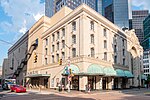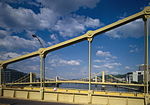Byham Theater

The Byham Theater is a landmark building at 101 Sixth Street in the Cultural District of Downtown Pittsburgh, Pennsylvania, United States. Originally built in 1903 as The Gayety Theater, the former vaudeville house was renovated and reopened as The Byham Theater in 1990. Built in 1903 and opened Halloween night 1904, the then-named Gayety Theater was stage and vaudeville house, and it featured stars such as Ethel Barrymore, Gertrude Lawrence, and Helen Hayes. It was renamed The Fulton in the 1930s when it became a full-time movie theater. The classic horror film Night of the Living Dead, which was filmed in and around Pittsburgh, had its world premiere at the Fulton in 1968. In 1990 the Pittsburgh Cultural Trust bought the theater and refurbished the Fulton as part of its plan for the Cultural District. Carolyn M. Byham and William C. Byham of Pittsburgh made a major naming gift for a 1995 renovation, and it has been the Byham Theater since.
Excerpt from the Wikipedia article Byham Theater (License: CC BY-SA 3.0, Authors, Images).Byham Theater
6th Street, Pittsburgh
Geographical coordinates (GPS) Address Nearby Places Show on map
Geographical coordinates (GPS)
| Latitude | Longitude |
|---|---|
| N 40.4439 ° | E -80.0025 ° |
Address
Renaissance Pittsburgh Hotel
6th Street 107
15222 Pittsburgh
Pennsylvania, United States
Open on Google Maps











